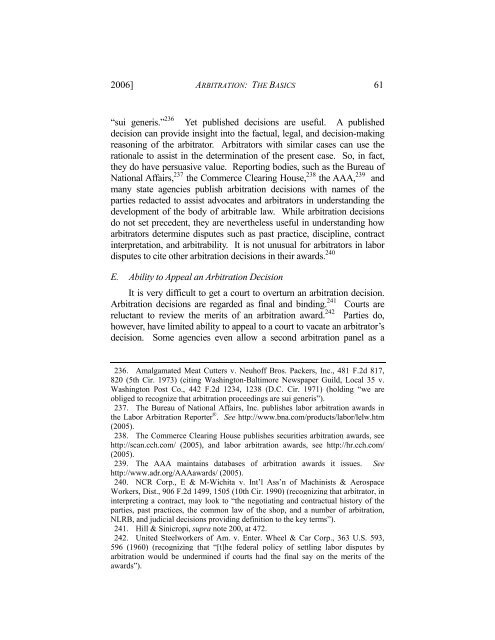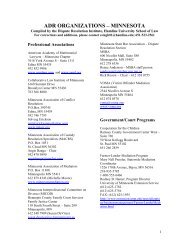2006/Vol. 5 No.1 - Hamline Law - Hamline University
2006/Vol. 5 No.1 - Hamline Law - Hamline University
2006/Vol. 5 No.1 - Hamline Law - Hamline University
You also want an ePaper? Increase the reach of your titles
YUMPU automatically turns print PDFs into web optimized ePapers that Google loves.
<strong>2006</strong>] ARBITRATION: THE BASICS 61<br />
“sui generis.” 236 Yet published decisions are useful. A published<br />
decision can provide insight into the factual, legal, and decision-making<br />
reasoning of the arbitrator. Arbitrators with similar cases can use the<br />
rationale to assist in the determination of the present case. So, in fact,<br />
they do have persuasive value. Reporting bodies, such as the Bureau of<br />
National Affairs, 237 the Commerce Clearing House, 238 the AAA, 239 and<br />
many state agencies publish arbitration decisions with names of the<br />
parties redacted to assist advocates and arbitrators in understanding the<br />
development of the body of arbitrable law. While arbitration decisions<br />
do not set precedent, they are nevertheless useful in understanding how<br />
arbitrators determine disputes such as past practice, discipline, contract<br />
interpretation, and arbitrability. It is not unusual for arbitrators in labor<br />
disputes to cite other arbitration decisions in their awards. 240<br />
E. Ability to Appeal an Arbitration Decision<br />
It is very difficult to get a court to overturn an arbitration decision.<br />
Arbitration decisions are regarded as final and binding. 241 Courts are<br />
reluctant to review the merits of an arbitration award. 242 Parties do,<br />
however, have limited ability to appeal to a court to vacate an arbitrator’s<br />
decision. Some agencies even allow a second arbitration panel as a<br />
236. Amalgamated Meat Cutters v. Neuhoff Bros. Packers, Inc., 481 F.2d 817,<br />
820 (5th Cir. 1973) (citing Washington-Baltimore Newspaper Guild, Local 35 v.<br />
Washington Post Co., 442 F.2d 1234, 1238 (D.C. Cir. 1971) (holding “we are<br />
obliged to recognize that arbitration proceedings are sui generis”).<br />
237. The Bureau of National Affairs, Inc. publishes labor arbitration awards in<br />
the Labor Arbitration Reporter ® . See http://www.bna.com/products/labor/lelw.htm<br />
(2005).<br />
238. The Commerce Clearing House publishes securities arbitration awards, see<br />
http://scan.cch.com/ (2005), and labor arbitration awards, see http://hr.cch.com/<br />
(2005).<br />
239. The AAA maintains databases of arbitration awards it issues. See<br />
http://www.adr.org/AAAawards/ (2005).<br />
240. NCR Corp., E & M-Wichita v. Int’l Ass’n of Machinists & Aerospace<br />
Workers, Dist., 906 F.2d 1499, 1505 (10th Cir. 1990) (recognizing that arbitrator, in<br />
interpreting a contract, may look to “the negotiating and contractual history of the<br />
parties, past practices, the common law of the shop, and a number of arbitration,<br />
NLRB, and judicial decisions providing definition to the key terms”).<br />
241. Hill & Sinicropi, supra note 200, at 472.<br />
242. United Steelworkers of Am. v. Enter. Wheel & Car Corp., 363 U.S. 593,<br />
596 (1960) (recognizing that “[t]he federal policy of settling labor disputes by<br />
arbitration would be undermined if courts had the final say on the merits of the<br />
awards”).
















